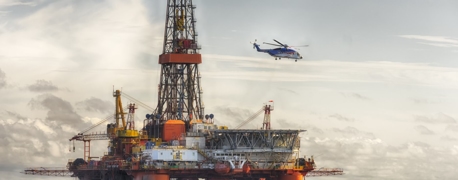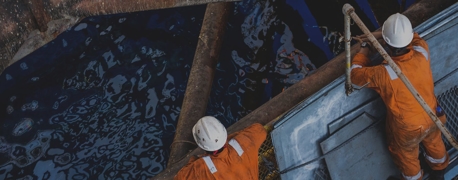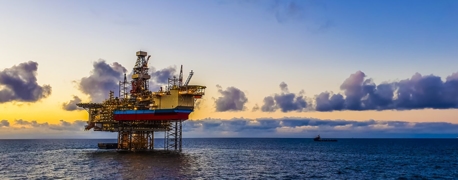Offshore Drilling for Oil: How Does It Work Exactly?

Oil has been the world’s most important energy source since the 1950s, and the United States is its biggest consumer. According to the U.S. Energy Information Administration (EIA), the United States consumed, on average, approximately 19.78 million barrels of petroleum every day in 2021. We use it for transportation, to heat our homes and other buildings, and to produce electricity. We even use it to create hundreds of other products, including plastics and solvents.
The United States is also the world’s top producer of crude oil. In 2021, the U.S. was responsible for 20% of crude oil production, amounting to approximately 18.88 million barrels per day.
While the majority of crude oil is obtained from wells drilled on land, offshore production is crucial to keeping up with the ongoing petroleum demand. About 15% of U.S. oil production comes from offshore drilling operations in the Gulf of Mexico. About 30% of global oil production comes from offshore operations located in oceans and other bodies of water across the planet.
A (Brief) History of Offshore Drilling in the U.S.
Because hundreds or thousands of feet of water lie between a drilling rig and the seafloor below, offshore oil production is far more expensive and challenging than oil and gas extraction on land. The first submerged oil wells were built around 1891 in Grand Lake St. Marys, Ohio. The lake is shallow, with an average depth of 5 to 7 feet and a maximum depth of just over 16 feet, which made it an ideal spot for early offshore drilling operations. More than 100 wells were built in the lake from 1891 to 1913.
The first offshore well to be constructed in saltwater was drilled at the end of a pier in Summerland, California, just 300 feet from shore. Over the next 5 years, 14 more piers and more than 400 additional wells were constructed in the area. That first well continued to produce for 25 years.
In 1911, the first offshore drilling operation was constructed without the use of a pier. Gulf Refining Company drilled in Caddo Lake, Louisiana, with a fleet of barges, tugboats, and floating pile drivers, creating the foundation for a new way of offshore drilling (and opening the door to operations further from shore and in deeper waters).
The first offshore well to be constructed in the Gulf of Mexico was built by Pure Oil and Superior Oil Company. The freestanding platform stood in 14-foot-deep water about 1 mile off the coast of Creole, Louisiana. By the end of 1949, 44 wells had been drilled in the Gulf of Mexico across a total of 11 oil and gas fields. Throughout the following decades, offshore drilling technology and equipment advanced rapidly.
Today’s offshore rigs are capable of drilling 250 miles from shore in waters up to 2 miles (10,560 feet) deep. What’s more, they can drill to depths of 28,000 feet below the seafloor. The deepest floating oil platform in the world is the Perdido, which is Spanish for “lost.” Operated by Shell, Chevron, and BP, the platform sits in 8,040-foot-deep water in the Gulf of Mexico. The Perdido is massive, with a structure that towers 876 feet above the water. The rig requires a crew of 172 people to operate it.
Offshore Drilling: Finding, Extracting & Transporting Crude Oil
The first step in the offshore drilling process is finding oil. This is accomplished by bouncing sound waves off the seabed with a device that uses compressed air to release high-pressure bursts of energy into the water. As the sound waves travel to the ocean floor and bounce back, they are recorded by special underwater microphones (hydrophones). Scientists can use this data to determine which areas of the ocean are likely to have viable oil and gas deposits.
Oil and gas companies aren’t allowed to simply search for oil wherever they please. They must purchase leasing rights from the proper authority. The United States has over 1.76 billion acres of offshore land. In accordance with the Submerged Lands Act (SLA), individual states have jurisdiction over the submerged lands lying from their coastlines to 3 nautical miles from shore, apart from Texas and Florida, whose submerged lands extend to 9 nautical miles from shore. The Outer Continental Shelf Lands Act (OCSLA) gives the federal government authority over offshore land that extends past state jurisdiction.
Even after a company has purchased offshore leasing rights, it must obtain a permit from the Bureau of Safety and Environmental Enforcement (BSEE) to drill a new well or modify an existing one. The BSEE receives approximately 140 applications each year and is tasked with reviewing these to determine whether drilling should be permitted based on environmental and safety concerns.
Exploratory Wells
Once a potential oil reserve has been found, an exploratory well will be drilled. This is done with a Mobile Offshore Drilling Unit, or MODU.
There are five main types of MODUs:
- Drilling Barges. Typically used in shallow water and calm weather and sea conditions, drilling barges are large floating platforms that are towed into position and anchored in place while drilling takes place. Drilling barges usually operate at water depths of approximately 15 to 150 feet and may drill to depths of 3.7 miles or more below the seabed.
- Submersible Rigs. Like drilling barges, submersible rigs operate in shallow water. Once they are in position, certain compartments are flooded with water to submerge part of the structure and allow it to rest on the seafloor. The maximum operating depth for most submersible rigs is 175 feet.
- Jack-Up Rigs. These drilling platforms sit on three or four massive legs grounded to the ocean floor. Jack-up rigs are towed into position, and then the legs are lowered to the seafloor. Once all the legs are in place, the platform is raised up above the water to keep it safe from changing tides and ocean swells. Jack-up rigs typically operate at water depths of approximately 80 to 500 feet and may drill to depths of 5.6 miles or more below the seabed.
- Semi-Submersible Rigs. Designed for offshore drilling in deep water, semi-submersible rigs are partially submerged during drilling operations and are moored with anchors (sometimes up to a dozen). These anchors are operated by computer systems that automatically adjust the tension on each chain to control drift, keeping the rig in place. Semi-submersibles may have their own propulsion systems to navigate to drilling sites, while others must be towed into place. These drilling rigs can operate in water depths of about 1,600 to 9,800 feet and can drill to depths of 6.2 miles or more below the seabed.
- Drill Ships. Like semi-submersibles, drill ships are built for deep-water drilling. They are also mobile, able to navigate to the drill site on their own and then use a combination of anchors and propulsion to keep the vessel steady as it drills for oil. Drilling equipment is located on the top deck of a drill ship; the drill operates through a hole in the hull. Drill ships can operate in extremely deep water, at depths of about 1,600 to 11,975 feet and can drill to depths of 7.45+ miles below the seabed.
Depending on the type of well and its location, as well as the type of MODU used, an initial well will be drilled and the MODU may be replaced with a more permanent rig to handle ongoing oil production.
Finding oil is not guaranteed, and that is why MODUs are used to drill exploratory wells. These rigs drill down into the ocean floor to see if they can find viable oil and gas deposits, using special equipment meant for underwater drilling. The first part of this equipment is the riser, which is the part of the drill that extends below the deck of the rig and through the water to the sea floor. A series of pipes called a drill string are lowered through the riser; these are designed to drill down into the seabed.
At the seabed, a key piece of equipment called a blowout preventer (BOP) is used to close off the pipe in the event of a blowout. As the MODU drills into the ocean floor, metal casings are used to stabilize the well and prevent it from collapsing in on itself. Each metal casing is lined with cement walls, and the casings get progressively narrower as the well gets deeper. The drill bits also get progressively smaller, and O-rings are used to seal the spots where narrower casings join with larger ones.
If a MODU finds oil, the next step is to prepare for production. This is done by sealing the well with a pair of plugs. The first plug will be located at the bottom of the well near the oil deposit; it is then covered with seawater or drilling mud to apply pressure that holds it in place while the second plug is set at the top of the well.
Production
Commercially viable oil wells may be drilled by one of various production platforms, depending on the type of offshore environment. Water depth, well depth, distance from shore, and other factors may influence what type of production platform is used. In some cases, the MODU itself may transition from exploration to production to extract oil from the well.
The following are the main types of production platforms:
- Fixed platforms, which typically operate in depths of up to 1,500 feet.
- Compliant towers, which are often used in depths of 1,000 to 2,000 feet.
- Tension leg platforms, which may be used in depths of up to 4,000 feet.
- Mini-tension leg platforms, which are used for smaller deep-water oil reserves.
- SPAR platforms, which currently drill in water depths of up to 3,000 feet.
- Floating production systems, which use semi-submersible units to drill in ultra-deepwater.
- Subsea systems, which are typically used in waters deeper than 5,000 feet.
- Floating production, storage, and offloading systems (FPSOs), which can drill and store oil before routinely offloading it using smaller shuttle tankers that take it to shore for processing
These offshore production platforms are responsible for extracting and processing crude oil from the rock formations below the seabed. They contain all the equipment and crew members necessary to keep offshore oilfields in production, process oil that has been extracted, and transport it to the coast. Offshore platforms are massive and complex, sometimes requiring more than 100 workers to operate. Because many of these rigs are located miles from shore, crews must remain on board, living and working on the platform for weeks at a time.
Transportation
Most offshore production platforms are not meant to store oil onboard; extensive pipeline systems are used to transport oil from platforms to the coast for processing and distribution. Infield pipelines, often referred to as feeder lines or flowlines, are used to transport a mixture of oil, gas, and water from subsea wells to platforms. Export pipelines move processed oil or gas from a platform to the coast.
Offshore oil exploration and production are complicated and often dangerous undertakings, but we rely on crude oil in many parts of our lives – even if we don’t realize it. At Arnold & Itkin, we are committed to helping the hardworking people of the oil and gas industry. We’ve been representing offshore workers and their families since 2004 and have taken on some of the biggest cases in maritime law, such as the Deepwater Horizon explosion and the sinking of the El Faro. Our offshore injury lawyers have fought the most formidable opponents and won, helping good people get answers and fair compensation after suffering the most atrocious injuries and losses.
We’re standing by if you have questions or want to talk to an attorney about your rights after an offshore accident or any incident. It’s free and confidential: call (888) 493-1629 to get started.
Additional Resources & Information
Looking to learn even more about offshore drilling? Check out the following articles:
- Categories


